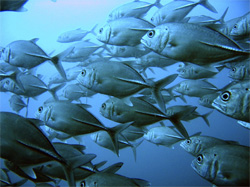
Chapter 23. Mercury Poisoning
Mercury Poisoning


Read the article below. Then complete the comprehension questions that follow.
What made the Mad Hatter 'mad'?
“Why is a raven like a writing desk?” asks the Mad Hatter in Lewis Carroll’s classic book, Alice in Wonderland. He later admits he doesn’t have an answer.
When Carroll wrote his book in the 19th century, hat makers (called “hatters”) used mercury solution to turn fur into felt. Inhaling the toxic fumes resulted in tremors, slurred speech, memory loss, and delirium.
Mercury was widely used in many industries before its dangers were fully understood. Its uses included medicines, dental fillings, mirror-making, and—perhaps its best known use—making thermometers. (See the box below.)
Today there are still people impacted by the metal mercury, although usually through long-term, low-level environmental exposure, as we will discuss in a bit. First we will take a look at mercury’s toxicological profile to see how it impacts the body.
Mercury’s toxicity
Once it enters the body, mercury can compete with minerals like zinc, magnesium, and iron, grabbing the biological spaces they would normally fill and interrupting their functions in the body. Mercury also has a strong affinity for sulfur. It disrupts enzyme function by binding to groups of atoms called thiols, which contain sulfur.
The most toxic forms of mercury—methyl and dimethylmercury—cross the skin easily. One of the most publicized recent mercury poisonings was that of Dartmouth University professor Karen Wetterhahn, who absorbed a few drops of dimethylmercury through her skin after spilling onto her latex glove. She died in 1997, just a few months after exposure.
Methyl and dimethylmercury are also easily absorbed into the bloodstream from the digestive system, and they even cross the placental barrier. This is why mothers with no symptoms can give birth to infants with severe mercury-related disabilities. Mercury interferes with neuronal development and can also affect cell division in the developing central nervous system. This is why pregnant and breast-feeding mothers are warned against eating a lot of wild-caught fish, as many species accumulate mercury.

Mercury is in fish because it is pervasive in their environment
Rain can carry mercury from mining, logging, and industrial operations to lakes and streams. Because mercury doesn’t break down, it gradually accumulates in bays and estuaries, eventually making its way to the oceans.
Mercury is lipophillic, or fat-loving. As fish meat is full of fatty acids, once absorbed, mercury is widely distributed through their tissue.
When fish consume contaminated algae or other foods, their proteins bind about 90% of methyl mercury. Through a process called bioaccumulation, the mercury ingested by smaller fish and bottom feeders is passed along to the larger predators that eat them. Since many of the fish we eat—including tuna—are near the top of the food chain, mercury exposure is a particular problem with seafood.
Because mercury is widespread in the ocean and also can be found in many large lakes, it’s difficult to avoid. Eating lower on the food chain will help reduce exposure to toxins. This strategy is also better for the environment, because it takes more ocean resources to replace large predators, like tuna. What's more, larger predators are slower to regenerate. In fact, many stocks now face collapse due to over-fishing.
In 1953, the accumulation of mercury in Japan’s Minamata Bay caused a mass poisoning incident. Microorganisms in the bay converted inorganic mercury released from a nearby plant into methyl mercury. After eating fish and shellfish, about 121 people were afflicted. Nearly one third died shortly after, and cases of severe birth defects were reported.

A poison that stays around a long time
While electronic thermometers are now far more common than those made with mercury, and mercury use in dental fillings is also rare, the metal is still used to preserve antibiotics and vaccines. Mercury also is used to make lab reagents like sodium hydroxide, which is why some universities now require the chemical manufactures they patronize to disclose internal processes. Mercury (as thiomersal) is still sometimes used in the manufacture of mascara; although, there has been movement to ban its use for this purpose.
Even with the use of mercury diminishing, it will continue to be a problem for people for the foreseeable future. This is because the mercury that is already in the environment (particularly in the oceans) is so persistent and resistant to breaking down.
Mercury and Thermometers
Mercury is perhaps best known for its use in old glass thermometers, where the metallic liquid moves up and down to indicate temperature change. Why was mercury used? Unlike freezing water, mercury doesn’t expand when it gets cold. It’s also the only common metal that remains liquid at normal room temperatures.
© 2015 WH Freeman and Company
23.1 Comprehension Questions
Answer the following questions to demonstrate your understanding of the article.
1.
What made 19th century hat makers (a.k.a. hatters) “mad”?
| A. |
| B. |
| C. |
| D. |
| E. |
2.
Mercury exposure can disrupt chemical reactions associated with an individual’s metabolism. This occurs because mercury causes to no longer function properly.
3.
What are some of the other ways that mercury can negatively impact the body and its normal functions? Select ALL that apply.
interrupts the function of minerals like iron and zinc in the body
dissolves proteins and enzymes
causes memory loss and slurred speech
interferes with neuronal development in fetuses
increases speed at which impulses move down axons of neurons
4.
Mercury use has been eliminated from many of today’s products; however, mercury still poses a potential health threat because ___________
| A. |
| B. |
| C. |
| D. |
| E. |
5.
Fill in the Blank:
Mercury was commonly used in to measure temperatures because, unlike water, mercury does not expand when it gets cold.
6.
Mercury is ingested by smaller fish and then passed along to the larger predators that eat them in a process called .
7.
True/False:
Eating certain foods from lower on the food chain may reduce your potential exposure to mercury.
8.
Scientists are studying an inland lake that was contaminated by toxic waste after an industrial accident a decade ago. The scientists discover fish in the lake contain substantial amounts of mercury, even though no additional toxins have been released into the lake since the accident. What is the best explanation for this finding?
| A. |
| B. |
| C. |
| D. |
| E. |
9.
Why should pregnant women avoid potentially mercury-contaminated fish?
| A. |
| B. |
| C. |
| D. |
| E. |
10.
Maya, who is 5-months pregnant, is having lunch with friends at a local restaurant known for its fresh seafood. Look at the restaurant menu below. Using the information from the article, choose the dish below that would have the LEAST amount of mercury and be the safest for Maya to eat. (Click on the item below to record your choice.)
{"title":"Seared Ahi","description":"No. Ahi Tuna tends to be extremely high in mercury.","type":"incorrect","color":"#ffff00","code":"[{\"shape\":\"rect\",\"coords\":\"3,88,397,119\"}]"} {"title":"Crab Cakes","description":"Yes! Since crabs are bottom feeders, Maya would probably be safest eating the crab cakes.","type":"correct","color":"#ffff00","code":"[{\"shape\":\"rect\",\"coords\":\"4,134,398,165\"}]"} {"title":"Yellowfin Tuna","description":"No. Although Yellowfin Tuna doesn’t tend to be as high in mercury as other varieties of tuna, Maya should still avoid it.","type":"incorrect","color":"#ffff00","code":"[{\"shape\":\"rect\",\"coords\":\"5,177,399,208\"}]"} {"title":"Wild Caught Mackerel","description":"No. Although bay scallops are a bottom feeder and would probably be okay for Maya to eat, she should avoid the King Mackerel. As the article points out, pregnant women are often advised to avoid top-feeding, wild-caught fish (such as Mackerel) because of their high mercury content.","type":"incorrect","color":"#ffff00","code":"[{\"shape\":\"rect\",\"coords\":\"5,218,399,249\"}]"}Activity results are being submitted...
